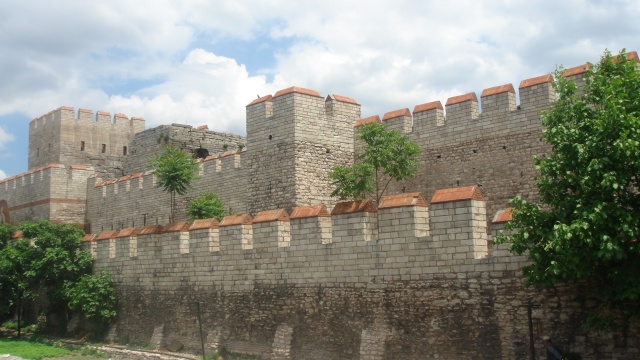Wulf: A Displaced Anglo-Saxon, c. 1090
It had been the better part of a lifetime since the Conquest, and Wulf was resolved to stay and settle in his adoptive city. His loyalty to his former liege lords had been remote and largely inherited; he had never seen Harold Godƿinson in the flesh and never personally sworn him an oath of fealty. The emperor Alexios I was another matter entirely. He was not terribly tall or broad shouldered, but Wulf had always found him firm and well spoken. He was courteous and generous with his foreign soldiers’ pay. Wulf was proud to be one of his personal guards and had thwarted several attempts on his life with zeal. He had fought with the emperor before in the field as well, and had no reason to think him anything but a capable commander. Wulf was generally fatalistic in temperament, but when he looked around him at the wonders of Alexios’s splendid city, he could not help praying that such a great and godly land would never be left open to foreign conquest.
Wulf had never considered himself particularly devout until coming to Constantinople. The world was turbulent enough and it was said permanence rested with the Lord alone, but that hadn’t done him any good in the meantime when he wandered without king or home. He recalled an old sentiment, Wel bið þam þe him are seceð, frofre to Fæder on heofonum, þær us eal seo fæstnung stondeð (“It is well for him, the one who seeks grace, comfort from the Father in the heavens, there, for us, all security stands”), but wondered if perhaps its author had never seen a city as magnificent as Constantinople. Wulf knew better than to assume any city could maintain unfailing stability, but surely this one more than most embodied permanence in Middangeard.
Wulf’s favorite thing about the city was, in fact, its many basilicas and monasteries, which he could survey from the life-guard’s quarters at the top of the imperial palace. He liked being able to turn any street corner and encounter a saint’s relic or local shrine. The largely unaltered nature of the rite, whether he accompanied the emperor to Hagia Sophia or attended services in any of these smaller chapels, reassured him. Even the smaller buildings tended to be larger and more ornate than anything he remembered from his childhood, in thicker-walled, dimmer structures across Wessex. Alexios’s Orthodox Christianity was of a different sort than Wulf’s Catholicism, but Wulf had so rarely been to regular church services when he was young, or in his travels across Europe, that it bothered him little. He had never spoken Latin, so he acclimated to the Greek liturgy easily enough. For all intents and purposes, Wulf was content to share God and temple with his emperor, and Alexios Komnenos was far more his emperor than Harold Godƿinson or the bastard William with his invading army would ever be.
Many of Wulf’s fellow life-guards were English as well, and he believed they tended to share his views of religion and allegiance. The majority of the guards hailed from the Northlands, and, while some were unrepentant adventurers who intended to return home wealthy, he found they predominantly agreed in attitude. Wulf had grown up with a nagging distrust of Danes, but face to face, they seemed like any other fighting man and their language was familiar from traders and settlers who remained in Wessex from Cnut’s time. Wulf noticed that the English portion of the guard was growing, however, and he found their company heartening. Some Greeks claimed they were all from Thule, but the emperor and many members of his court seemed to be able to tell most of them apart. Wulf himself was not necessarily much better when it came to distinguishing Geonoese from Venetians, or Arabs from Turks, though he believed he was gradually improving. As Wulf intended to stay in the emperor’s guard for the foreseeable future and remain in the city after that, he assumed his abilities to recognize other foreigners would develop with time.
Brigid Ehrmantraut

The walls of Constantinople (Wikimedia commons)
Further Reading
Primary Sources (listed in their English translation ed.):
Accounts of Medieval Constantinople: The Patria. Translated by Albrecht Berger. Harvard: Dumbarton Oaks Medieval Library, 2013.
Grettis Saga. Translated by William Morris & Eirikr Magnusson. Edited by Sveinbjorn Thordarson. Icelandic Saga Database, 2007. http://sagadb.org/grettis_saga.en.
Hrafnkells saga freysgoða. Translated by John Coles. Edited by Sveinbjorn Thordarson. Icelandic Saga Database, 2008. http://sagadb.org/hrafnkels_saga_freysgoda.en .
Komena, Anna. The Alexiad. Translated by E.R.A. Sewter. Edited by Peter Frankopan. New York: Penguin Classics, 2009.
Laxdæla saga. Translated by Muriel A.C. Press. Edited by Sveinbjorn Thordarson. Icelandic Saga Database, 2007. http://sagadb.org/laxdaela_saga.en.
Liutprand of Cremona. “Relatio de Legatione Constantinopolitana,” in The Works of Liudprand of Cremona. Translated by F.A. Wright. London 1930.
Psellos, Michael. Chronographia. Translated by E.R.A Sewter. New Haven: Yale University Press, 1953.
“The Wanderer.” In The Old English Elegies, edited by Anne L. Klinck. Montreal: McGill-Queen’s Press, 2001.
Secondary Sources:
Blöndal, Sigfús and Benedikt S. Benedikz. The Varangians of Byzantium: An Aspect of Byzantine Military History. 1978. Reprint, Cambridge: Cambridge University Press, 2007.
Androshchuk, F. O. Vikings In the East: Essays On Contacts Along the Road to Byzantium (800-1100). Uppsala : Uppsala Universitet, 2013.
Marinis, Vasileios. “Defining Liturgical Space,” in The Byzantine World, edited by Paul Stephenson. New York: Routledge, 2010.
“Viking ‘graffiti.’” National Museum of Denmark. 2017. http://en.natmus.dk/historical-knowledge/denmark/prehistoric-period-until-1050-ad/the-viking-age/expeditions-and-raids/viking-graffiti/.
Thomas, Hugh M. “The Significance and Fate of the Native English Landholders of 1086.” The English Historical Review 118, no. 476 (2003): 303-33. http://www.jstor.org/stable/3490123.
A quick note on translations:
The Old English quotation comes from the closing lines of “The Wanderer,” and Anglo-Saxon poem found in the Exeter Book; the translation is my own. Heilagr fróðleikr is my attempt to render “Hagia Sophia” in Old Norse. Old English and Old Norse proper nouns are all attested in the Primary Reading list.

